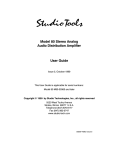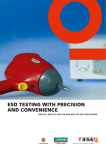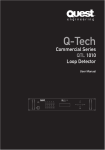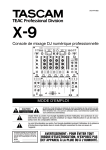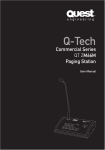Download Quest Engineering QA 1004 User manual
Transcript
QA SERIES QA 1004 | QA 2004 | QA 3004 | QA 4004 POWER AMPLIFIERS user manual QA SERIES User Manual CONTENTS / SAFETY Contents Safety 02-03 Introduction to QA Series 04 Connections 05 Amplifer installation information 06-07 Installation procedure 08-09 System configuration diagrams 09-10 Specifications 11 Safety Precautions Carefully read the user manual fully prior to use. Improper use can cause damage to the amplifier and any speakers attached to it. Please be aware of correct wiring and configurations as directed in the Installation section of this manual. Do not attempt to clean any plastic parts with solvents or petrochemical based cleaners. Installation allowing direct precipitation is not advised and installation practise must prevent liquids from entering the box. Do not place sources of heat on or around the amplifier such as lighting equipment or smoke machines, and where possible please keep out of direct sunlight. Do not place magnetic sensitive equipment on or around amplifiers The power voltages inside this device are high and could cause serious injury or death if touched while the power is connected. Do not open the amplifier case as there are no user serviceable parts inside. User Manual QA Series Power Amplifiers QA SERIES User Manual 1. Read all the documentation accompanying your amplifier before operating. 6. Do not locate amplifiers close to sources of heat or moisture. 2. Make absolutely sure the power supply is wired correctly. This can be done with a commercially available power supply tester. This especially applies to three-phase distribution boards where an incorrectly wired or intermittent neutral line can cause excessive voltages causing permanent damage to any 230-110 volt equipment connected to it. It is good practice to test the power for polarity and voltage range. Faulty wiring is commonly the source of many audio difficulties. 7. Keep air intake area clear. It is good practice to clean filter regularly and occasionally check the amplifier is not clogged with dust. A hot amplifier rack is a sign of inadequate maintenance or poor installation. 3. Always operate the amplifier with the earth or ground connected. When powered from a generator, make sure there is a viable earth connection. 4. Check that the external power wiring is in good condition. Do not connect to damaged or frayed wiring. 5. Confirm that the amplifier outputs are correctly connected before operating. This particularly applies to multiple speaker arrays here incorrect wiring can lead to an accidental parallel connection to another amplifier’s output causing damage to both amplifiers. Register Your Product Thank you for choosing Quest. Please take the time to complete your procuct registration card which is included with the packaging. Registering your Quest Engineering product will: 8. Occasionally check the cooling fans are functioning. If an amplifier shuts down as a result of excessive heat, distorts or is not sounding as it should, check the speaker wiring, power supply, (too low or too high), fan operation and input gain structure for non standard setup. 9. Check your amplifier rack is clear of loose cable ties, screws and stray wirers that can obstruct fans or allow entry of anything that can cause short circuit. SAFETY Installation Precautions 3 10. The amplifier should be returned to Quest Audio service centre for service by qualifier personnel if service is required. 11. Output voltages from the QA Series are potentially high. Use only well insulated quality speaker cable of suitable gauge. (See section covering installation and wiring recommendations) • CONFIRM YOUR WARRANTY • REGISTER YOUR PRODUCT • PROTECT YOUR NEW PRODUCT QA Series Power Amplifiers User Manual QA SERIES User Manual INTRODUCTION TO QA Quest QA Series Power Amplifiers 4 Introduction Congratulations on your purchase of a new QA Series professional power amplifier. Quest Engineering QA Series amplifiers are engineered and built to a standard that will satisfy the most demanding environments of both mobile live sound and permanent installation audio. Unpacking Please inspect the amplifier carefully immediately after unpacking. If you find any damage, notify your supplier/dealer immediately. Only the shipper may file a damage claim with the carrier for damage incurred during shipping. Be sure to save the carton and all packing materials for the carrier’s inspection. For your safety and continuing reliability of your Quest amplifier, please read all the safety instructions and familiarise yourself with the amplifiers functions and installation procedure section before installing and operating the amplifier. If your packing materials are in good condition, please save them. If you ever need to ship the unit back to Quest Engineering or an authorised service centre, you are advised to use the original factory packing. Attention to detail In order to maintain strict quality assurance standards, all QA Series amplifiers are built and tested in Quest Engineering’s own manufacturing facility. Electronic components are the finest grade available, and sub-assemblies are tested at every stage before final assembly. Each amplifier is then subjected to stress testing before shipping. It follows that if your audio installation is completed with the same attention to detail, your amplifier will deliver its best results. It is recommended to make sure all the mixers and signal processors in the signal chain to the amplifier are set correctly. Clean un-distorted power will not just sound better; it will also help your speakers give you a long service life. User Manual QA Series Power Amplifiers QA SERIES User Manual CONNECTIONS , + * ) ’ ( - . Lk Lm Lo Lp 5 CAUTION OFF 35Hz 80Hz STEREO PARALLEL BRIDGE HIGH PASS -A OFF 80Hz 1.4V 32dB OUTPUT A 26dB GAIN MODE RISK OF ELECTRIC SHOCK DO NOT OPEN 110Hz LOW PASS -A LINK A INPUT A PIN1: SIGNAL GND PIN2: SIGNAL + PIN3: SIGNAL - BRIDGE MODEL: OUTPUT ASSIGNMENT PIN 1+ : SIGNAL GROUND PIN 1- : Push To Reset HIGH PASS -B OFF 35Hz 80Hz LOW PASS -B OFF 80Hz GROUND LIMITER 110Hz ON OFF LIFT OUTPUT B GROUND DESIGNED BY QUEST ENGINEERING,AUSTRALIA LINK B INPUT B N2388 / Ll 1. ON/OFF Switch. 2. LEVEL Control of the input level of the external signal in 3dB increments. 3. POWER Status available. 4. SIGNAL Signal status indicators: These LEDs indicate signal presence for both the inputs of channel A and B. 5. PEAK Status indicates when amplifier is approaching clipping. 6. PROTECT The protect LED indicates that one of the various amplifier protection circuits has been activated.*If LED remains on please return amplifier to a certified service technician. 7. INPUTS Channel A/B balanced XLR inputs: pin 1 ground, pin 2 + and pin 3 8. HIGH PASS FILTER Selectors for A & B. 9. LOW PASS FILTER Seclectors for A & B. Ln ~ 220 240V 10A 50/60Hz Lq 10. MODE This switches amplifier operational mode from Stereo/Parallel Mono or Bridge Mono. Input is across channel A. Minimum speaker impedance is 8Ω in bridge mode. Please refer to page 7 of this manual for correct wiring instructions.ALWAYS SWITCH OFF AMPLIFIER BEFORE OPERATING BRIDGE SWITCH . 11. LIMITER Switches between off and on. 12. GAIN Input switch to calibrate mixer line level to amplifier input sensitivity. 13. GROUND Seperates electrical earth from that of chassis ground. 14. OUTPUTS Channel A/B and Bridge Outputs. Speakon NL4 connectors output on pin1+ and 115. RESET Push circuit breaker to reset amplifier. 16. MAINS INPUT Main power input IEC. SWITCH OFF AMPLIFIER BEFORE OPERATING BRIDGE SWITCH QA Series Power Amplifiers User Manual QA SERIES User Manual INSTALLATION Notes for better amplifier performance 6 • Amplifier gain The amplifier should always be operated with the input level controls set at maximum. The only departure from this practice is where the internal filters/crossover is engaged in a bi-amp configuration, where it may be necessary to turn down the high frequency side of the amplifier. If the amplifier needs to be calibrated, to match a mixer line level output, the gain switch on the back of the amplifier can be switched to the correct line level. The objective of correct gain settings is to have all the segments of the audio chain from the preamplifier/ equalisers/compressors/crossovers matched to the amplifier. A test tone should take every link in the chain to 0 dB or +4 dB at the same input level. This way, a mixer VU indicator is a real visual clue as to how hard the whole system is running and no single element will be adding distortion before the system is at full power. Some brands of speaker system are designed to be monitored and controlled by a dedicated system controller that is wired directly to the output of the amplifier. These systems measure both the input and output from the amplifier and monitor the signal for best results from the speaker system. To engage the amplifier’s limiter will interfere with the controllers sensing circuit, so the amplifier limiter must be disengaged. • The air intakes The two filtered air intakes have removable filters for cleaning. The air intakes should be unobstructed and allow the free flow of air. • High- and low-pass filters The filter system in a QA series amplifier is a basic switchable high/low pass crossover. It can also be used to filter out sub-harmonic low bass frequencies the speaker system cannot reproduce and waste amplifier power. It is particularly recommended to switch in the 35 Hz High Pass filter when the amplifier is being used to power band-pass type bass boxes. The amplifier can be used to power a bass system without the need for an electronic crossover by switching the high-pass to 35Hz and the low-pass to 80 or 110Hz. The input link A/B XLR connectors at the back of the amplifier will remain full-range, so a fullrange signal can be daisy chained to another amplifier or powered speaker. • Amplifier limiter The switchable limiter is designed to prevent the amplifier from clipping or distorting, there by causing speaker damage. It should always be engaged except in the circumstance where the amplifier is being used in conjunction with an amplifier sensing speaker system controller. User Manual QA Series Power Amplifiers The filters should be removed and cleaned as needed. Running the amplifier without the filters will allow the amplifier to fill with dust and foreign particles and could void the warrantee under some circumstances. • Rack-mounting amplifiers for the road The Chassis of the QA series is fabricated from Q235 Cold Steel Rolling and is quite durable. However, suspending an amplifier in free space in a rack and then vibrating in the back of a truck for long rough journeys may cause fatigue to the front panel mounting. It is essential that the amplifier be supported from the front and rear in rack-mounting especially when the amplifier rack is to be transported. Failure to install correctly may void warrantee. IMPORTANT: Clean air filters regularly and always allow adequate ventilation and do not block air flow to amplifier! 2" minimum all around AIR FLOW ↑ 2" ↓ ←2"→ rack cabinet AIR FLOW Parallel Mono is selected when you have an odd number of speakers, such a three. Instead of leaving the amplifier in stereo two-channel mode and driving two on one side and one on the other. By selecting Parallel Mono you can parallel all three and drive them with equal power when connected to either or both speaker outputs. Parallel mono is also more desirable for the amplifier for speaker loads of 3-4Ω. Care must be taken with speaker connections to never have the amplifier outputs joined together by a daisy chain of speaker connections . In this configuration channel A level control is also used to control amplifier level. AIR FLOW AMPLIFIER (TOP VIEW) ←2"→ Bridge Mono is elected when you need to get the most power available when driving a total load of 8 Ω or more. In this configuration channel A level control is used to control amplifier level. AIR FLOW • Bridge/Parallel mono The Bridge/Parallel mono mode is selected to convert the two-channel amplifier into a mono amplifier of greater power. This configuration would be selected when for example more power is needed to drive sub bass boxes to higher power. The functional difference between the bridge mono and parallel mono is determined by the speaker impedance of your intended speaker system. INSTALLATION QA SERIES User Manual 7 • Recommendations for speaker cables Speaker cable needs to be as heavy gauge as conveniently possible for low-loss results. Light gauge cable (below 1.5mm) will create extra resistance and waste amplifier power–this particularly applies to long speaker runs. The damping factor statistic (“punch” for the non technical) is greatly diminished so keep your speaker cables short and fat. Quality microphone cable will also lower noise and improve high frequency response Using the guidlines below, select the appropriate size of wire based on the distance from amplifier to speaker distance wire size indicitive up to 25 ft 16AWG 25-40 ft 14AWG 41-60 ft 12AWG 61-100 ft 10AWG 101-150 ft 8AWG 151-250 ft 6AWG CAUTION: Never use shielded cable for output wiring QA Series Power Amplifiers User Manual QA SERIES User Manual INSTALLATION Installation Procedure 8 Mains Power Connection Before connecting the amplifier to the mains power, make certain that the voltage corresponds with that indicated on the rear of the amplifier. A variation of 10% is acceptable. Refer to safety warnings before switching on. Power Up It is standard procedure to power up the amplifiers last and shut down first. The QA series amplifiers feature turn on delays as the power up diagnostic circuits search for faults, so turn on “thump” is avoided. The speaker outputs are switched into circuit once checks are complete and normal operating voltages are present at all stages of the amplifier. When powering up multiple amplifiers, a staged turn on is suggested as the power surge of simultaneously switching on multiple amplifiers can exceed the power supply capability causing circuit breakers to disengage. Power Requirements The QA Series amplifier is capable of high output voltages. When multiple amplifiers will be operating simultaneously, make sure the power supply is adequate for all amplifiers to draw full power. In this case three phase power of sufficient Amperage supply capacity will give best results from your amplifiers. In the case where power is to be supplied from mobile generators, It may help to “load the generator” with some lighting to create a reserve of power from the generator for the amplifiers. Amplifiers do not necessarily draw high continuous power as lighting will, but have a high demand for dynamic power and can draw very high amounts of current for short durations. If the power in not available, distortion and reduced performance will result. Rack mount installation In permanent installation or mobile rack mounting it is recommended to secure the amplifier from both front and rear rack mounting facilities. For mobile application, this practice is absolutely essential. Damage to the amplifier caused by incorrect rack mount installation or transit damage is not covered by the warrantee. Installation and electrical interference Avoid installing your amplifier near sources of magnetic fields such as radio transmitters, welding equipment, User Manual QA Series Power Amplifiers high current transformers, lighting dimmers or electric motors. All signal cables should be physically isolated from power cables and all audio and amplifier power should be supplied via a circuit separate from lighting or stage machinery power. Failure to observe this standard may generate unwanted noises and hum to the audio system. Connecting cables When connecting the audio system, use only balanced three conductor signal cable of high quality (screen pin1 plus two signal carriers pin2/3). Low cost cable is more inclined to pick up radio frequencies and noise under certain conditions. For speaker cabinets, always use two core copper high current cables of suitable length. The thicker the copper core, the less the loss on a long speaker line. It follows to not make speaker cable runs longer than necessary. Long runs of thin cable will greatly reduce the excellent damping factor of the QA series amplifiers causing a loss of “punch” in the bass response. The rule of thumb is to use as thick a copper core as is practical. It is impossible for a cable to have too much copper but too little will cause losses of power and reduced damping factor. Unnecessarily long speaker cable runs will have the same effect, especially when left in a tight coil from a high powered amplifier. 1. BALANCED GND 1 2 SHIELD 3 2 FROM PREAMPLIFIER I NP U T 2. UNBALANCED 1 + 3 + FROM P RE A M P L I F I E R I N PUT + + SHIELD SHIELD 1. Balanced input connector wiring. 2. Unalanced input connector wiring. Bridge mono operation In Bridge mono mode, the output of channel A input buffer amplifier is connected to both channel A and channel B power amplifiers. The signal is routed in a manner to bring the channels onto opposite polarity to QA SERIES User Manual each other. The A channel handles the positive voltage swing and the B channel becomes the negative, thus doubling the output voltage swing. Via the “bridge output” speaker connector, the speaker is now connected across the two channels. Output is via the middle Speakon connector. The output signal is across pins number 1+,1-. Power is proportional to the square of the voltage swing, so four times the output power is possible. The reality is that this would exceed the capability of the output stage but a considerable increase in output will result all the same. ALWAYS SWITCH OFF AMPLIFIER BEFORE OPERATING BRIDGE SWITCH 3. SPEAKON CONNECTOR WIRING 2+ The minimum load impedance in bridge mono mode is 8Ω 12- Caution: In this mode output voltages are high enough to constitute a shock hazard. 1+ INSTALLATION Wiring will need to conform to CLASS 1 wiring standards. Check your local electrical codes for the appropriate electrical standards. 3. Speakon input and output connector wiring. 9 System configuration diagrams Stereo Operation STEREO MODE CAUTION OFF 35Hz 80Hz STEREO PARALLEL BRIDGE 80Hz 1.4V MODE HIGH PASS -A OFF 32dB 26dB GAIN OUTPUT A RISK OF ELECTRIC SHOCK DO NOT OPEN 110Hz LOW PASS -A LINK A INPUT A PIN1: SIGNAL GND PIN2: SIGNAL + PIN3: SIGNAL - MODEL: BRIDGE OUTPUT ASSIGNMENT PIN 1+ : SIGNAL PIN 1- : GROUND Push To Reset HIGH PASS -B OFF 35Hz 80Hz OFF 80Hz GROUND LIMITER LOW PASS -B 110Hz ON OFF LIFT GROUND DESIGNED BY QUEST ENGINEERING,AUSTRALIA LINK B INPUT B OUTPUT B ~ 220 240V 10A 50/60Hz QA Series Power Amplifiers User Manual QA SERIES User Manual Parallel-Mono Operation PARALLEL MODE SWITCH AMPLIFIER OFF BEFORE ENGAGING MONO/BRIDGE SWITCH OR SERIOUS AMPLIFIER DAMAGE WILL RESULT CAUTION OFF 35Hz 80Hz STEREO PARALLEL BRIDGE 1.4V MODE HIGH PASS -A OFF 80Hz 32dB 26dB GAIN OUTPUT A RISK OF ELECTRIC SHOCK DO NOT OPEN 110Hz LOW PASS -A LINK A INPUT A PIN1: SIGNAL GND PIN2: SIGNAL + PIN3: SIGNAL - MODEL: BRIDGE OUTPUT ASSIGNMENT PIN 1+ : SIGNAL PIN 1- : GROUND Push To Reset HIGH PASS -B INSTALLATION OFF 35Hz 80Hz 80Hz GROUND LIMITER LOW PASS -B OFF 110Hz ON OFF LIFT GROUND OUTPUT B DESIGNED BY QUEST ENGINEERING,AUSTRALIA LINK B ~ 220 INPUT B 240V 10A 50/60Hz 10 Bridge-Mono Operation BRIDGE MODE SWITCH AMPLIFIER OFF BEFORE ENGAGING MONO/BRIDGE SWITCH OR SERIOUS AMPLIFIER DAMAGE WILL RESULT CAUTION OFF 35Hz 80Hz STEREO PARALLEL BRIDGE HIGH PASS -A OFF 80Hz 1.4V 32dB 26dB GAIN MODE OUTPUT A RISK OF ELECTRIC SHOCK DO NOT OPEN 110Hz LOW PASS -A LINK A INPUT A PIN1: SIGNAL GND PIN2: SIGNAL + PIN3: SIGNAL - MODEL: BRIDGE OUTPUT ASSIGNMENT PIN 1+ : SIGNAL GROUND PIN 1- : Push To Reset HIGH PASS -B OFF 35Hz 80Hz LIMITER LOW PASS -B OFF 80Hz 110Hz ON GROUND OFF LIFT GROUND DESIGNED BY QUEST ENGINEERING,AUSTRALIA LINK B User Manual QA Series Power Amplifiers INPUT B OUTPUT B ~ 220 240V 10A 50/60Hz QA SERIES User Manual QA 1004 QA 2004 QA 3004 QA 4004 Rated Power (2 x 8 Ohms) 290 W per channel @ 1 kHz at <0.1% T.H.D.both channels driven 490 W per channel @ 1 kHz at <0.1% T.H.D. both channels driven 660 W per channel @ 1 kHz at <0.05% T.H.D. both channels driven 1,090 W per channel @ 1 kHz at <0.05% T.H.D. both channels driven Rated Power (2 x 4 Ohms) 575 W per channel @ 1 kHz at <0.1% T.H.D.both channels driven 870 W per channel @ 1 kHz at <0.1% T.H.D. both channels driven 1100 W per channel @ 1 kHz at <0.05% T.H.D. both channels driven 2,000 W per channel @ 1 kHz at <0.05% T.H.D. both channels driven T.H.D. <0.1%@250 W per channel from 20 HZ to 20 kHz >0.5% @ 400 W per >0.1% @ 400 W per channel from 20 Hz to 20 kHz channel from 20 Hz to 20 kHz Minimum Load Impedance 4 Ohms – sine wave 4 Ohms – sine wave Phase Response +5 to -15 from 20 Hz to 20 kHz +20 to -25 from 20 Hz to 20 kHz Input Impedance 20k Ohms, balanced; 10k Ohms, unbalanced 20k Ohms balanced 10k Ohms unbalanced Cooling Two temperature dependant variable speed 80mm high output DC fans Controls Two front panels attenuators, rear panel mode switch and gain select switch Two temperature dependant variable speed 120mm high output DC fans Two front panels attenuators, rear panel mode switch and gain select switch Hi Pass: Linkwitz-Reily (24 db/Octave) Off/35/80 Hz Off/35/80 Hz Low Pass: Linkwitz-Reily (24 db/Octave) Off/80/110 Hz Off/80/110 Hz Voltage Gain @ 0.775V 29 dB or 24 dB Crosstalk Hum and Noise 35 dB or 29 dB 38 dB or 32 dB >-60 dB @ 1 kHz at rated power @ 8 Ohms >-60 dB @ 1 kHz at rated power @ 8 Ohms >-60 dB @ 1 kHz at rated power @ 8 Ohms >-105 dB, “A” weighted >-107 dB, “A” weighted referenced to referenced to rated rated power @ 8 Ohms power @ 8 Ohms >-107 dB, “A” weighted referenced to rated power @ 8 Ohms >-104 dB, “A” weighted referenced to rated power @ 8 Ohms Slew Rate >30V/us >40V/us Damping Factor (8 Ohms) >500:1 @ 20 Hz - 1 kHz >700:1 @ 20 Hz - 1 kHz Protection 32 dB or 26 dB XLR, Speakon speaker output, 240/230 V 16 amps IEC mains Construction Dimensions 11 >44V/us >800:1 @ 20 Hz - 1 kHz Thermal, DC, turn-on bursts, subsonic, incorrect loads Connectors SPECIFICATIONS Quest Engineering QA Series Amplifiers: Specifications* Thermal, DC, turn-on bursts, subsonic, incorrect loads XLR, Speakon speaker output, 240/230 V 20 amps IEC mains Cold Steel Rolling + Machined aluminium front panel Cold Steel Rolling + Machined aluminium front panel 89 x 483 x 496 mm 132 x 483 x 496 mm Net Weight 17 kg 21 kg 23 kg 35 kg Packaged Shipping Weight 20 kg 23 kg 26 kg 38 kg * All specifications are correct at time of printing, Quest Engineering reserves the right to change specifications at any time and won’t be held responsible for any typographic errors in this publication. QA Series Power Amplifiers User Manual www.questaudio.net














